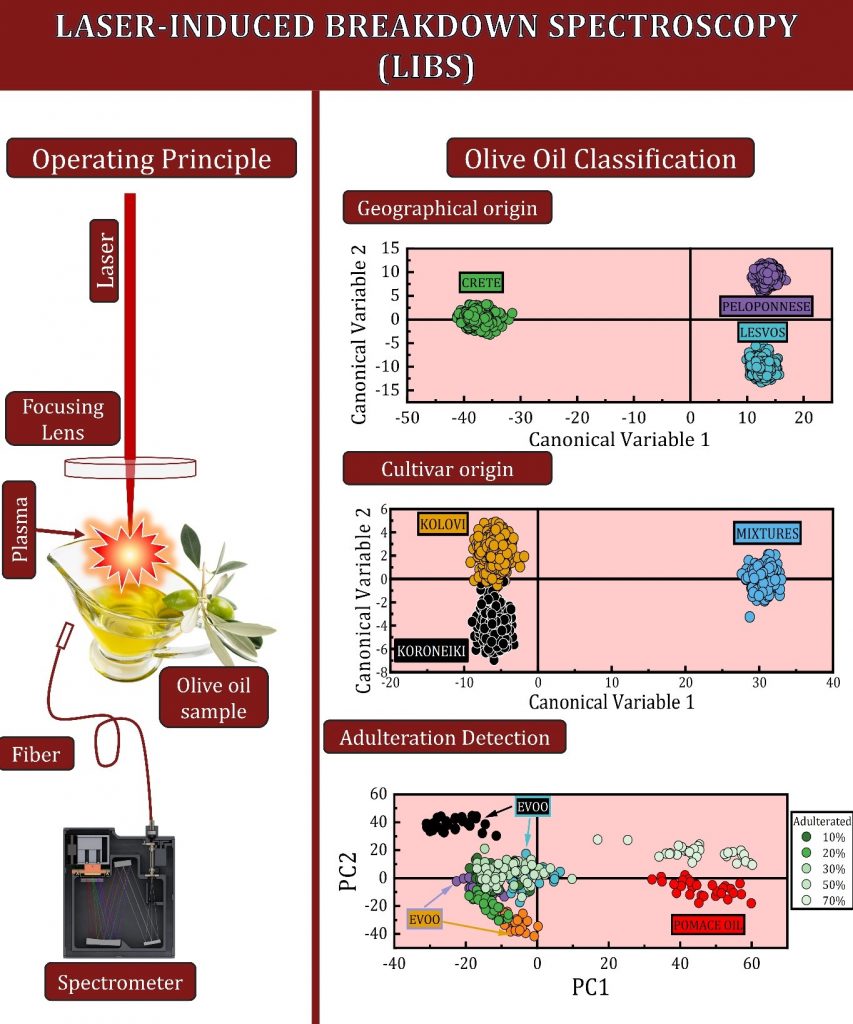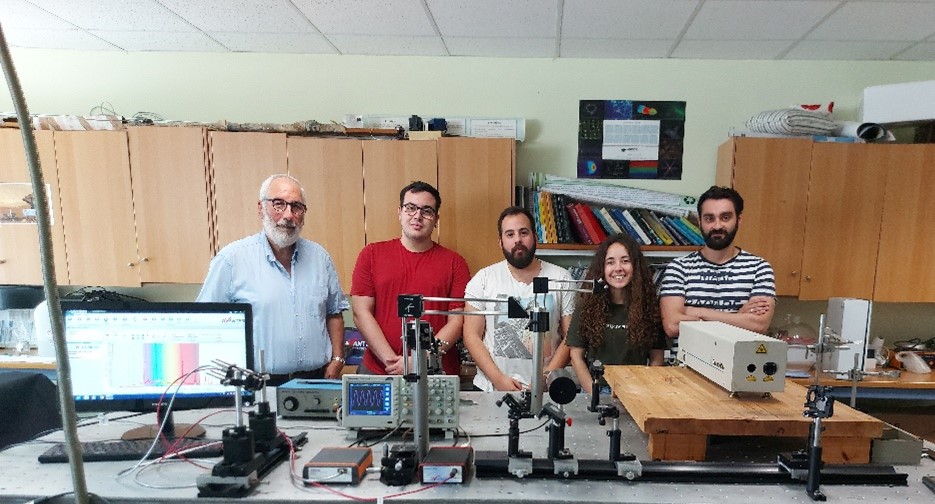By Stelios Couris
Olive oil constitutes a basic element of the so-called “Mediterranean diet”. Today, the Mediterranean countries are responsible for almost 90% of the worldwide olive oil production. This is because the climate in the Mediterranean region favors the cultivation of olive trees, while the variability of the climatic conditions results in olive oils with different characteristics, as e.g. flavor, color, smell, acidity, etc. Other factors that affect olive oil characteristics include the cultivation method of the olive trees, the degree of olive ripening and the extraction method of the olive oil from the olives.
In the last 20 years, consumption of olive oil across the world has increased significantly, in part due to the promotion efforts of the International Olive Council (IOC) and the European Union (EU), highlighting its high nutritional value. Public awareness of its health benefits places it among the most consumed products, having an impact on its market price. In addition to this, when the olive oil of a region is given a Designation of Origin (PDO) and/or Protected Geographical Indication (PGI), which recognizes its unique properties, it becomes a brand name. This provides additional value, resulting in higher market prices.
Inevitably, this situation makes olive oil more prone to adulteration by other lower cost vegetable oils (such as, by way of example, pomace oil). Olive oil blended with other lower-price oils from different sources, is difficult to be detected, which has allowed this adulteration practice to become widespread, thus becoming a serious problem for the olive oil industry, the market and society.
In order to prevent such fraudulent activities, and for quality control reasons, various analytical techniques have been proposed and some of them are routinely used, as for instance, the pH determination of fatty acids and the chromatographic detection of various olive oil compounds (e.g., gas and high performance liquid chromatography), while several spectroscopic methods have been also suggested, such as Atomic Absorption Spectroscopy (AAS), Fourier Transform Infrared Spectroscopy (FT-IR), Nuclear Magnetic Resonance Spectroscopy (NMR) and Raman Spectroscopy. However, although these methods can be very sensitive, they usually require expensive and sensitive equipment and qualified personnel, while they are time-consuming, because of the sample preparation procedures required [1].
Therefore, a rapid, low cost, reliable and accurate enough method can be of great utility for olive oil quality control and analysis. Laser-induced breakdown spectroscopy (LIBS) fulfils the above criteria. LIBS is a laser-based spectroscopic technique, usually employed for the elemental composition of different materials. LIBS is based on the creation of a micro-plasma on a sample’s surface resulting from the interaction of a laser beam with the sample, and the subsequent analysis of the emitted light. The procedure takes few seconds, while no previous preparation actions are needed. Due to its unique advantages, over the years, LIBS has been applied in a variety of different research areas with great success, ranging from recycling of metallic and/or plastic materials, to metallurgy, and art conservation [2-5]. Very recently, LIBS has been proposed for food research related applications, coinciding with the rapidly increasing recognition of the effectiveness of machine learning approaches for analytical purposes and spectroscopic analysis. Machine learning algorithms are capable to find pattern formation and/or correlations within the LIBS spectral data, thus the combination of LIBS with machine learning algorithms paved the way for new possibilities in the fields of laser-based analysis of materials, food science and safety and food quality control [6].
In that context, our team employed LIBS for the analysis of olive oils and with the assistance of machine learning, very promising results have been achieved. For instance, our group has succeeded the discrimination between adulterated and non-adulterated olive oil samples (adulteration with pomace oil) [7], the discrimination of olive oils based on their geographical origin (region of Crete, Lesvos and Peloponnese in Greece) [8-10], and lastly, the discrimination of virgin olive oils based on their cultivar (Kolovi and Koroneiki along with mixtures of them) [11] with accuracies exceeding 90% and, in some cases, even 95%.


The NLOLA Lab team (Dept. of Physics, University of Patras & ICEHT/FORTH): Dimitrios Stefas, Nikolaos Gyftokostas, Eleni Nanou, Panagiotis Kourelias, Prof. Stelios Couris
Collaborators from Computer Engineering & Informatics Dept.: Prof. Christos Bouras, Dr. Vasileios Kokkinos

Stelios Couris received his degree in Physics from the Department of Physics, University of Athens in 1980. He got a PhD from the University of Paul Sabatier of Toulouse (France) in 1984, being fellow of the French Government. After 2-years obligatory military service, he continued postdoctoral studies at the University of Toulouse, as a fellow of European Union and then, as a NATO fellow at the Central Research Laboratories of GTE Sylvania (now Osram Sylvania) in Boston (USA). Then, he got a position of Visiting Professor at the Physics Department, University of Crete and as researcher at the Institute of Electronic Structure & Laser (IESL) of the Foundation for Research and Technology-Hellas (FORTH), at Heraklion, Crete, where he was appointed as Assistant Researcher in 1993 and Principal Researcher in 1997. In 2000 he was appointed Associate Professor at the Physics Department, University of Patras and, in 2004, as Full Professor of Physics and Laser Applications. Since 2000 he is a collaborating faculty member with the Institute of Chemical Engineering Sciences (ICE-HT) of FORTH at Patras.
The research activities of S. Couris and his group concern:
- the physics and the mechanisms of the nonlinear optical response of novel advanced photonic materials (e.g., fullerenes and derivatives, graphenes, functionalized graphenes and derivatives, silicenes, 2D materials, plasmonic nanoparticles, photonic polymers, hybrid and organic materials; etc.) in time scales ranging from milliseconds (10-3 s) to few femtoseconds (10-15 s).
- laser spectroscopy (atomic and molecular multiphoton ionization spectroscopy, time-of-flight-laser ionization spectroscopy, coherent Raman spectroscopy, laser induced fluorescence, etc.)
- plasma physics and diagnostics, physics and spectroscopy of electrical discharges
- laser induced plasmas and their analytical applications for environmental issues, metallurgy, combustion diagnostics, surface treatment of materials, etc.
- the development of laser-based analytical techniques for the control of authenticity, adulteration and safety of food (e.g., olive oil, honey, milk) assisted by advanced machine learning techniques.
His research work includes more than 190 research papers in internationally recognized journals and has gained significant international recognition having received more than 5200 citations (h-index 40). He has coordinated/participated in many European and national competitive projects and has developed many international collaborations with foreign universities and research centers. More information is available on the website of the Non-Linear Optics and Laser Applications Laboratory (NLOLA Lab):
References
- Conte, L., Bendini, A., Valli, E., Lucci, P., Moret, S., Maquet, A., Lacoste, F., Brereton, P., García-González, D. L., Moreda, W., & Gallina Toschi, T. (2020). Olive oil quality and authenticity: A review of current EU legislation, standards, relevant methods of analyses, their drawbacks and recommendations for the future. Trends in Food Science & Technology, 105, 483–493. https://doi.org/10.1016/j.tifs.2019.02.025
- Stefas, D., Gyftokostas, N., Bellou, E., & Couris, S. (2019). Laser-Induced Breakdown Spectroscopy Assisted by Machine Learning for Plastics/Polymers Identification. Atoms, 7(3), 79. https://doi.org/10.3390/atoms7030079
- Palagas, C., Stavropoulos, P., Couris, S., Angelopoulos, G., Kolm, I., & Papamantellos, D. (2007). Investigation of the Parameters Influencing the Accuracy of Rapid Steelmaking Slag Analysis with Laser-Induced Breakdown Spectroscopy. Steel Research International, 78(9), 693–703. https://doi.org/10.1002/srin.200706271
- Anglos, D., Couris, S., & Fotakis, C. (1997). Laser Diagnostics of Painted Artworks: Laser-Induced Breakdown Spectroscopy in Pigment Identification. Applied Spectroscopy, 51(7), 1025–1030. https://doi.org/10.1366/0003702971941421
- Guo, L. B., Zhang, D., Sun, L. X., Yao, S. C., Zhang, L., Wang, Z. Z., Wang, Q. Q., Ding, H. B., Lu, Y., Hou, Z. Y., & Wang, Z. (2021). Development in the application of laser-induced breakdown spectroscopy in recent years: A review. Frontiers of Physics, 16(2). https://doi.org/10.1007/s11467-020-1007-z
- Markiewicz-Keszycka, M., Cama-Moncunill, X., Casado-Gavalda, M. P., Dixit, Y., Cama-Moncunill, R., Cullen, P. J., & Sullivan, C. (2017). Laser-induced breakdown spectroscopy (LIBS) for food analysis: A review. Trends in Food Science & Technology, 65, 80–93. https://doi.org/10.1016/j.tifs.2017.05.005
- Bellou, E., Gyftokostas, N., Stefas, D., Gazeli, O., & Couris, S. (2020). Laser-induced breakdown spectroscopy assisted by machine learning for olive oils classification: The effect of the experimental parameters. Spectrochimica Acta Part B: Atomic Spectroscopy, 163, 105746. https://doi.org/10.1016/j.sab.2019.105746
- Gyftokostas, N., Stefas, D., Kokkinos, V., Bouras, C., & Couris, S. (2021). Laser-induced breakdown spectroscopy coupled with machine learning as a tool for olive oil authenticity and geographic discrimination. Scientific Reports, 11(1). https://doi.org/10.1038/s41598-021-84941-z
- Gyftokostas, N., Stefas, D., & Couris, S. (2020). Olive Oils Classification via Laser-Induced Breakdown Spectroscopy. Applied Sciences, 10(10), 3462. https://doi.org/10.3390/app10103462
- Gyftokostas, N., Nanou, E., Stefas, D., Kokkinos, V., Bouras, C., & Couris, S. (2021). Classification of Greek Olive Oils from Different Regions by Machine Learning-Aided Laser-Induced Breakdown Spectroscopy and Absorption Spectroscopy. Molecules, 26(5), 1241. https://doi.org/10.3390/molecules26051241
- Stefas, D., Gyftokostas, N., Kourelias, P., Nanou, E., Kokkinos, V., Bouras, C., & Couris, S. (2021). Discrimination of olive oils based on the olive cultivar origin by machine learning employing the fusion of emission and absorption spectroscopic data. Food Control, 130, 108318. https://doi.org/10.1016/j.foodcont.2021.108318

